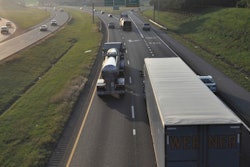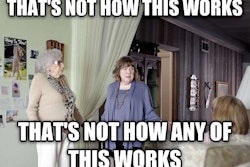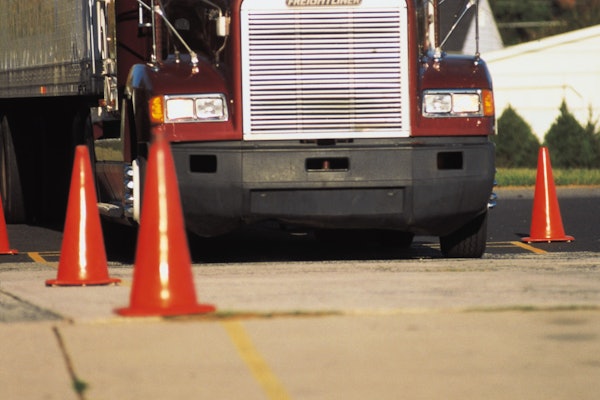
“I think this is one of those rulemakings that is going to die an ignominious death … especially in light of the new administration coming into Washington.” –Joe Rajkovacz on NHTSA/FMCSA’s speed-limiter proposed rule
Former owner-operator Joe Rajkovacz, now representing the Western States Trucking Association, addressed attendees of the National Association of Small Trucking Companies’ annual meeting here in Nashville last week. As usual, his talk contained more than a few items of note for owner-operators and small fleets, not least among them his good news view on where the speed-limiter mandate is going (see above) and less-sunny thoughts about a somewhat recent California Air Resources Board meeting mulling possibilities of a new Ultra-Low NOx emissions standard — that one holds the possibility of further pushing up the cost of new diesels. $200,000 trucks would not be far off under such a scenario, he said.
The air quality management districts in California, Rajkovacz said, wanted an “Ultra-Low NOx” emissions standard in the Phase 2 greenhouse gas regs, and those districts, among others, have petitioned the Environment Protection Agency for such this year. The reason they want it is that “EPA has dropped ambient air quality standards … and there’s virtually no place in California,” he added, that can meet that standard.
Meanwhile, he recently attended what he called the California Air Resources Board’s first meeting aimed at potentially setting up such a standard itself, which might force further engine emissions technology updates on diesel manufacturers. “We very much are going to be working with some of our allies in Congress and in the new administration,” Rajkovacz said, which gave him hope that such moves might not come to fruition.

What it could mean for owner-operators, as noted, is more money spent on equipment — and a further fuel-mileage penalty.
The Ports of L.A. and Long Beach, too, are looking at requiring zero-emissions vehicles to serve drayage there in the more distant future, he said. “When you start talking zero-emissions vehicles, you’re talking about a $400,000” truck, “at a minimum,” he added. “You’re not going to have a whole lot of owner-operators in a marketplace like that.”
At once, with the new incoming administration and Republicans in control of Congress, Rajkovacz joked that “I may be out of a job,” given the declining likelihood he’d be writing many official comments on rulemakings, which have come at a rapid clip in recent years. While he suspects the ELD mandate, given it was written into law by a Republican-controlled Congress, may be here to stay, bright spots for owner-operators include his prediction on speed limiters and more — likewise a turnaround in what he called the “war on independent contractors” on the West Coast, likelihood that the Safety Fitness Determination rulemaking is put on the backburner, and more. Find a few highlights below, and hear more via the podcast:
The pre-2000 model year exemption to ELD mandate compliance: It’s based on the “model year of the chassis” of the vehicle in question, “not the engine,” Rajkovacz underscored. “You know a lot of folks … were buying glider kits and putting old engines in them. Should have been buying old trucks and putting new engines in them. They could have been exempted from this.”
FMCSA recently clarified just how the exemption will be determined at roadside with an early-October publication in the Federal Register of a variety of regs clarifications. Contrary some recent reporting (not in Overdrive) suggesting FMCSA had changed its position that the vehicle VIN would determine exemption from the mandate, notes spokesman Duane DeBruyne, “FMCSA has not changed its position in terms of reliance on the VIN. However … identifying a single, efficient means of determining a CMV model year is especially critical during roadside inspections. Thus, as part of a technical corrective rule issued on October 4, 2016, FMCSA clarified the pre-2000 model-year exemption, adding the words ‘as reflected in the vehicle identification number as shown on the vehicle’s registration.’ … The tenth character of a 17-character VIN, printed on a vehicle registration, indicates the model year.” That’s what roadside officers will use to determined exemption from compliance.
On picking an ELD to comply with the coming mandate: Members of Rajkovacz’ association are “getting spoonfed ELDs” by “snake oil salesmen,” he said, that are not on FMCSA’s registry of self-certified devices but which said salesmen claim are. Rajkovacz notes a technical spec related to the exchange of information that is as yet unsettled — we’ve written about it here — and he said is keeping a lot of the major historical electronic-log providers away from certifying on the registry as yet.
Most owner-operators’ wait-and-see approach to getting on board with the mandate may be prudent, too, he noted, given recent FMCSA reps’ statements about what would happen should an ELD provider be de-certified after the mandate goes into effect. The motor carrier would then be responsible for quickly — possibly within as few as eight days — changing providers.
Speed limiters: “In truth,” said Rajokvacz, “I think this is one of those rulemakings that is going to die an ignominious death … especially in light of the new administration coming into Washington.” Rajkovacz presents an argument that, given the benefit side of the cost-benefit equation in calculations included in the NHTSA/FMCSA co-produced proposal is heavily tilted toward fuel savings, NHTSA should have pursued this rulemaking not with the motor carrier safety agency but with EPA. Without environmental savings, Rajkovacz contends, the speed-limiter proposal never gets out of the White House Office of Management and Budget due to a lopsided cost-benefit analysis.
Two weeks remain in the comment period for the speed-limiter proposal.
On formal comments to the docket for any rulemaking: Calling FMCSA a bunch of communists is not going to help you prove your case, no doubt. “Congratulations, you vented,” Rajkovacz said, “but you didn’t accomplish a thing.” Rajkovacz takes a pragmatic approach to going after rulemakings. The ELD mandate is a case in point, whose publication came with FMCSA asking a question about pre-2000 model year trucks and whether they can be as a general rule equipped with an electronic logging device. Rajkovacz’ association, then called the California Construction Trucking Association, determined an average cost for such a retrofit and provided it to regulators. The results can be seen in the text of the ELD mandate itself:
The California Construction Trucking Association said that while it is possible to retrofit an older truck, its research indicates that it is costly, at about $1,000 per truck in California.
No other trucking-industry commenters addressed that cost, only ELD device makers.
Comments have indicated and FMCSA’s research has confirmed that pre-2000 model year trucks may not allow the ELD to connect easily to the engine. While the Agency has confirmed that there are ways of equipping older vehicles to use an ELD consistent with today’s rule technical specifications, these are not always cost beneficial or practical. Further, the Agency lacks confidence that the technology will be available to address this entire segment of the market (pre-2000 model years) at a reasonable cost.
Hence, we have the pre-2000 model year exception to mandate compliance.
On representation on the MCSAC advisory committee: Rajkovacz believes the federal advisory committee to the FMCSA should have greater industry representation with members serving on a rotating basis — not in perpetuity. For more background on the issues he raised, read this story.
FMCSA’s “Beyond compliance” proposals, required by Congress with the FAST Act: For “an effective beyond compliance program that allows motor carriers relief from regulatory burdens,” Rajkovacz offered: What if that could include a proven record of hours compliance and on-highway safety that gave relief from having to install ELDs? Not a sure thing, no doubt, but it’s an idea that could be brought to the table as efforts on Beyond Compliance continue.













